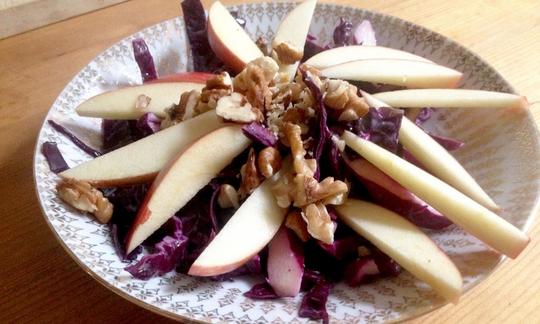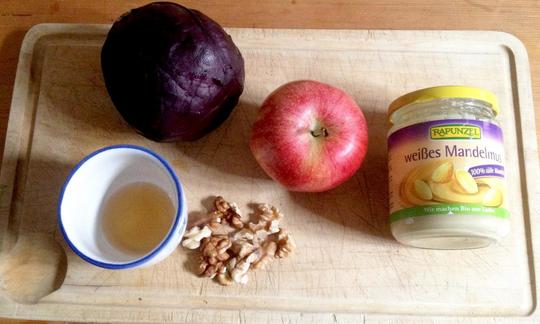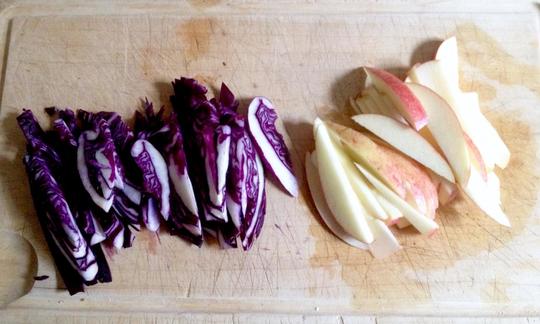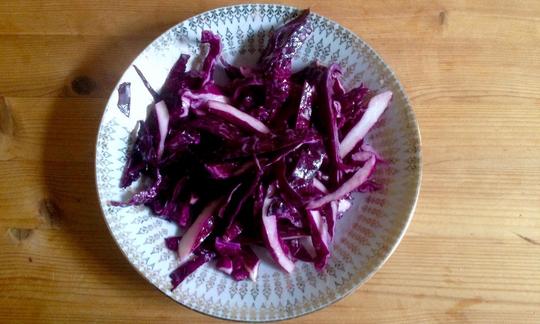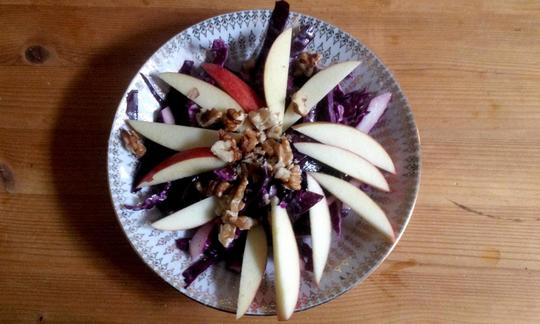Red cabbage and apple salad with walnuts and almond butter
raw-vegan
Ingredients (for servings, )
| For salad base and garnish | |
|---|---|
| 13 oz | Red cabbage, raw (organic?) |
| 1 | Apple Gala, raw (organic?) (6.0 oz) |
| 1 oz | Walnuts (tree nuts), raw (organic?) |
| For the dressing | |
| 2 tbsp | Apple cider vinegar (raw?, organic?) (1.0 oz) |
| 2 tbsp | Almond butter, unsalted (raw?, organic?) (1.1 oz) |
| 3 dash | Table salt (table salt, raw?, organic?) (0.04 oz) |
Type of preparation
- chop or grind
- food preparation without heating
- meld
Preparation
For salad base and garnish
Cut the red cabbage and apple into thin strips using a sharp knife.If the salad is not to be eaten until a few hours later or the next day, do not use the apples and the nuts required in the next step of the recipe.
Roughly chop the nuts needed for the red cabbage and apple salad and set aside.
In the case of walnuts, these can be easily chopped by hand; depending on the type of nut, chopping can also be done quickly and easily with a hammer/rolling pin and a kitchen towel that is wrapped around the nuts.
For the dressing
Mix almond butter, apple cider vinegar and salt with a wooden spoon or spoon until a homogeneous dressing is formed.Put the red cabbage strips in a bowl and massage the dressing in with your hands. Leave to stand for 20 minutes.
Arrange the apple strips on the red cabbage and garnish with the nuts.
|
Nutritional Information per person
Convert per 100g
|
2000 kcal | |
|---|---|---|
| Energy | 304 kcal | 15.2% |
| Fat/Lipids | 19 g | 27.2% |
| Saturated Fats | 1.6 g | 8.1% |
| Carbohydrates (inc.dietary fiber) | 30 g | 11.2% |
| Sugars | 17 g | 18.9% |
| Fiber | 8.4 g | 33.6% |
| Protein/Albumin | 8.4 g | 16.9% |
| Cooking Salt (Na:284.2 mg) | 722 mg | 30.1% |
| Essential micronutrients with the highest proportions | per person | 2000 kcal | |
|---|---|---|---|
| Vit | Vitamin C (ascorbic acid) | 110 mg | 137.0% |
| Vit | Vitamin K | 70 µg | 94.0% |
| Fat | Linoleic acid; LA; 18:2 omega-6 | 8.0 g | 80.0% |
| Fat | Alpha-Linolenic acid; ALA; 18:3 omega-3 | 1.4 g | 72.0% |
| Min | Manganese, Mn | 1.4 mg | 68.0% |
| Min | Copper, Cu | 0.44 mg | 44.0% |
| Vit | Vitamin B6 (pyridoxine) | 0.52 mg | 37.0% |
| Elem | Potassium, K | 727 mg | 36.0% |
| Sodium, Na | 284 mg | 36.0% | |
| Vit | Vitamin E, as a-TEs | 4.3 mg | 36.0% |
Detailed Nutritional Information per Person for this Recipe
The majority of the nutritional information comes from the USDA (US Department of Agriculture). This means that the information for natural products is often incomplete or only given within broader categories, whereas in most cases products made from these have more complete information displayed.
If we take flaxseed, for example, the important essential amino acid ALA (omega-3) is only included in an overarching category whereas for flaxseed oil ALA is listed specifically. In time, we will be able to change this, but it will require a lot of work. An “i” appears behind ingredients that have been adjusted and an explanation appears when you hover over this symbol.
For Erb Muesli, the original calculations resulted in 48 % of the daily requirement of ALA — but with the correction, we see that the muesli actually covers >100 % of the necessary recommendation for the omega-3 fatty acid ALA. Our goal is to eventually be able to compare the nutritional value of our recipes with those that are used in conventional western lifestyles.
| Essential fatty acids | per person | 2000 kcal |
|---|---|---|
| Linoleic acid; LA; 18:2 omega-6 | 8.0 g | 80.0% |
| Alpha-Linolenic acid; ALA; 18:3 omega-3 | 1.4 g | 72.0% |
| Essential amino acids | per person | 2000 kcal |
|---|---|---|
| Tryptophan (Trp, W) | 0.07 g | 29.0% |
| Threonine (Thr, T, irreversibly transaminated) | 0.25 g | 27.0% |
| Isoleucine (Ile, I) | 0.28 g | 23.0% |
| Phenylalanine (Phe, F) | 0.36 g | 23.0% |
| Valin (Val, V) | 0.35 g | 22.0% |
| Leucine (Leu, L) | 0.50 g | 21.0% |
| Lysine (Lys, K, irreversibly transaminated) | 0.25 g | 13.0% |
| Methionine (Met, M) | 0.08 g | 9.0% |
| Vitamins | per person | 2000 kcal |
|---|---|---|
| Vitamin C (ascorbic acid) | 110 mg | 137.0% |
| Vitamin K | 70 µg | 94.0% |
| Vitamin B6 (pyridoxine) | 0.52 mg | 37.0% |
| Vitamin E, as a-TEs | 4.3 mg | 36.0% |
| Vitamin B9, B11 (Folate, as the active form of folic acid) | 58 µg | 29.0% |
| Vitamin B2 (Riboflavin) | 0.32 mg | 23.0% |
| Vitamin B1 (Thiamine) | 0.19 mg | 17.0% |
| Vitamin A, as RAE | 102 µg | 13.0% |
| Vitamin B7 (Biotin, ex vitamin H) | 5.3 µg | 11.0% |
| Vitamin B3 (Niacin) | 1.5 mg | 9.0% |
| Vitamin B5 (Pantothenic acid) | 0.45 mg | 7.0% |
| Essential macroelements (macronutrients) | per person | 2000 kcal |
|---|---|---|
| Potassium, K | 727 mg | 36.0% |
| Sodium, Na | 284 mg | 36.0% |
| Phosphorus, P | 198 mg | 28.0% |
| Magnesium, Mg | 102 mg | 27.0% |
| Calcium, Ca | 158 mg | 20.0% |
| Essential trace elements (micronutrients) | per person | 2000 kcal |
|---|---|---|
| Manganese, Mn | 1.4 mg | 68.0% |
| Copper, Cu | 0.44 mg | 44.0% |
| Iron, Fe | 2.6 mg | 18.0% |
| Zinc, Zn | 1.4 mg | 14.0% |
| Selenium, Se | 2.2 µg | 4.0% |
| Fluorine, F | 0.01 µg | < 0.1% |
| Iod, I (Jod, J) | 0.45 µg | < 0.1% |
The red cabbage and apple salad with walnuts and almond butter presented here is a wintery, fruity combination and is suitable as a side dish or starter.
Red cabbage: The following information come from Wikipedia. Red cabbage has many names, for example in Germany it is known regionally as blue cabbage, blue cabbage and red cabbage. In Switzerland it is called red cabbage or blue cabbage. This is because the cabbage can actually have different colors - depending on the soil in which it grows. Acidic soils produce a red color, while alkaline soils produce a blue one. This principle also works during processing in the kitchen: vinegar promotes a red color, baking powder produces red cabbage.
Prepare the salad in advance: The salad can also be prepared several hours or a day before consumption. The cabbage will then infuse particularly well. However, it should be noted that the apple will lose its beautiful color and become too soft if it oxidizes.
Therefore, in this case, first just cut the red cabbage, marinate it and add the apple and nuts shortly before serving.
Cooked food variant: Delicious, but no longer completely raw, is also a variant with roasted walnuts. To do this, put the chopped nuts dry (i.e. without oil) in a pan and roast them for 5 minutes at a medium heat, shaking them occasionally. This will give them a very special aroma and lose some of their bitter note.
Nut variations: Instead of walnuts, other varieties such as hazelnuts or the somewhat more exotic macadamia nuts are also suitable.

